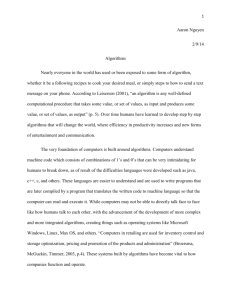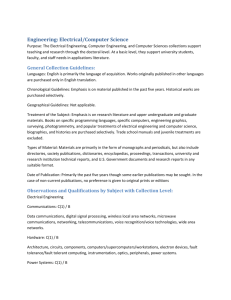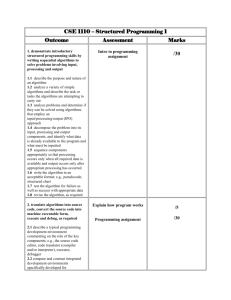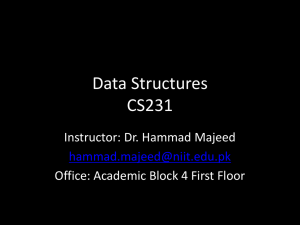File - Southglade Primary SCHOOL
advertisement
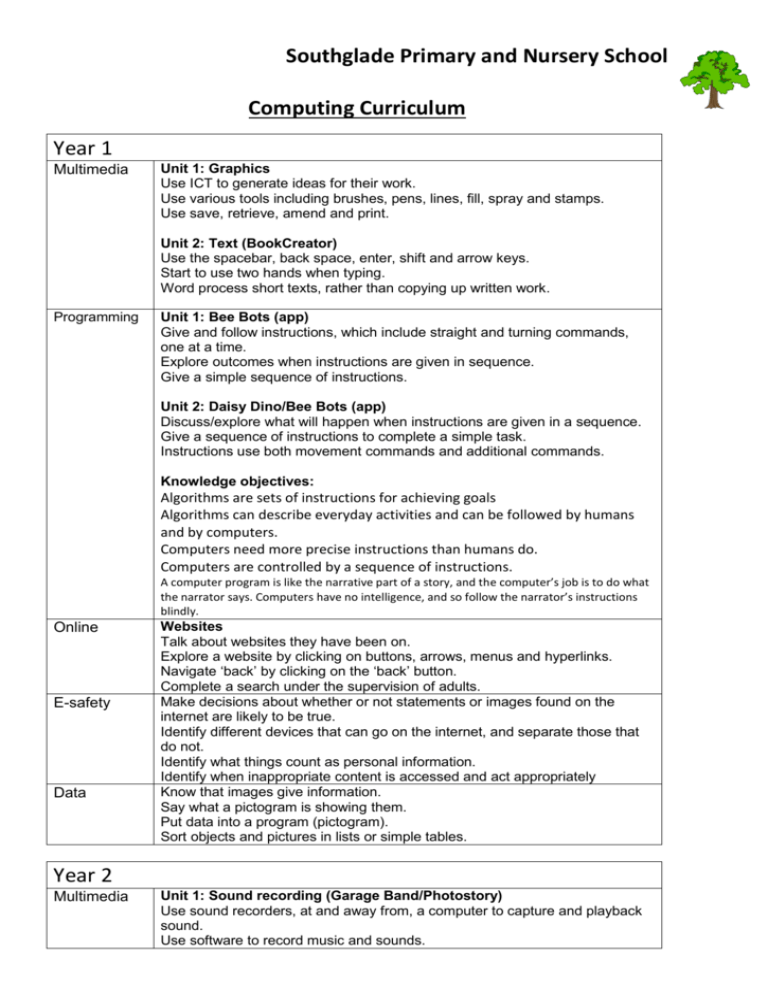
Southglade Primary and Nursery School Computing Curriculum Year 1 Multimedia Unit 1: Graphics Use ICT to generate ideas for their work. Use various tools including brushes, pens, lines, fill, spray and stamps. Use save, retrieve, amend and print. Unit 2: Text (BookCreator) Use the spacebar, back space, enter, shift and arrow keys. Start to use two hands when typing. Word process short texts, rather than copying up written work. Programming Unit 1: Bee Bots (app) Give and follow instructions, which include straight and turning commands, one at a time. Explore outcomes when instructions are given in sequence. Give a simple sequence of instructions. Unit 2: Daisy Dino/Bee Bots (app) Discuss/explore what will happen when instructions are given in a sequence. Give a sequence of instructions to complete a simple task. Instructions use both movement commands and additional commands. Knowledge objectives: Algorithms are sets of instructions for achieving goals Algorithms can describe everyday activities and can be followed by humans and by computers. Computers need more precise instructions than humans do. Computers are controlled by a sequence of instructions. A computer program is like the narrative part of a story, and the computer’s job is to do what the narrator says. Computers have no intelligence, and so follow the narrator’s instructions blindly. Online E-safety Data Websites Talk about websites they have been on. Explore a website by clicking on buttons, arrows, menus and hyperlinks. Navigate ‘back’ by clicking on the ‘back’ button. Complete a search under the supervision of adults. Make decisions about whether or not statements or images found on the internet are likely to be true. Identify different devices that can go on the internet, and separate those that do not. Identify what things count as personal information. Identify when inappropriate content is accessed and act appropriately Know that images give information. Say what a pictogram is showing them. Put data into a program (pictogram). Sort objects and pictures in lists or simple tables. Year 2 Multimedia Unit 1: Sound recording (Garage Band/Photostory) Use sound recorders, at and away from, a computer to capture and playback sound. Use software to record music and sounds. Change sounds they have recorded. Save, retrieve and edit sounds. Unit 2: Video (iMovie app) Capture video. Discuss which videos to keep and why. Arrange clips to make a short film that conveys meaning. Add simple titles and credits. Select text and make simple changes including bold, italic and underlined. Programming Unit 1: Daisy Dino Use the ‘repeat’ (loop) and ‘when’ (conditional statement) command within a series of instructions. Plan a short ‘story’ for a sprite and write the commands for this. Edit/refine a sequence of commands. Unit 2: Move the turtle Generate a sequence of instructions including ‘right angle’ turns. Create a sequence of instructions to generate simple geometric shapes (oblong /square). Discuss how to improve/change their sequence of commands. Knowledge objectives: Steps can be repeated within algorithms Algorithms can be represented in simple formats [storyboards and narrative text] Particular tasks can be accomplished by creating a program for a computer. Some computers allow their users to create their own programs. Email E-Safety Data Recognise an email address. Find the @ key on a keyboard. Contribute to a class email. Open and select to reply to an email as a class. Identify obviously false information in a variety of contexts. Recognise that a variety of devices (XBox, PSP etc as well as computers and phones) connect users with other people. Identify personal information that should be kept private. Consider other people’s feelings on the internet. Remember and use Sidʼs Top Tips. Place objects and pictures in a list or a simple table. Make a simple Y/N tree diagram to sort information. Create and search a branching database. Year 3 Multimedia Unit 1: Graphics Acquire, store and combine images from cameras or the internet for a purpose. Use the print screen function to capture an image. Select certain areas of an image and resize, rotate an image. Edit pictures using various tools in paint or photo-manipulation software. Unit 2: eBooks (BookCreator) Create a new eBook with a front cover and add or remove pages. Combine text and images within each page and embed sound clips. Add information about the author and title for publishing. Get quicker at typing using both hands. Use different fonts sizes, colours and effects to communicate meaning. Align text left, right and centre Programming Unit 1: Hopscotch app Use a variety of inputs Use the ‘repeat’ (loop) command within a series of instructions. Use the ‘if… then’ (conditional statement) command within a series of instructions Unit 2: Logo Write a simple program in Logo to produce a line drawing. Use more advanced Logo programming, including pen up, pen down etc. Write a program to reproduce a defined problem, e.g. geometric shape/pattern. Knowledge objectives: Algorithms can be represented symbolically [flowcharts] or using instructions in a clearly defined language [turtle graphics]. Algorithms can include selection (if) and repetition (loops). Algorithms should be stated without ambiguity and care and precision are necessary to avoid errors. Algorithms are developed according to a plan and then tested. Algorithms are corrected if they fail these tests. A computer program is a sequence of instructions written to perform a specified task with a computer. Programs can be created using visual tools. Online Unit 1: Blogging Navigate to view their class/school blog. Understand that their class/school blog can be updated from a range of devices. Comment on their class/school blog. Subscribe with an adult’s email to receive updates about their class/school blog. Unit 2: Internet research Type in a URL to find a website. Add websites to favorites. Use a search engine to find a range of media, e.g. images, text. Think of search terms to use linked to questions they are finding the answers for. Talk about the reliability of information on the internet, e.g. the difference between fact and opinion (link to E-Safety) E-Safety Question the “validity” of what they see on the internet. Use a browser address bar not just search box and shortcuts. Think before sending and suggest consequences of sending/posting. Recognise online behaviours that would be unfair. Data Choose information to put into a data table. Recognise which information is suitable for their topic. Design a questionnaire to collect information. Sort and organise information to use in other ways. Year 4 Multimedia Unit 1: Animation (I can animate app) Plan what they would like to happen in their animation. Take a series of pictures to form an animation. Move items within their animation to create movement on playback. Edit/improve their animation. Unit 2: Video (iMovie trailer) Capture video for a purpose. Discuss the quality of videos and chose which to keep and which to re-shoot. Trim and arrange clips to convey meaning. Add titles, credits, slide transitions, special effects and talk about the effect these have on the audience. Programming Unit 1: Scratch Racing car Navigate the Scratch programming environment. Create a background and sprite for a game. Add inputs to control their sprite. Use conditional statements (if… then) within their game. Unit 2: Kodu Single player - free to navigate and avoid danger Create a 3D digital world for a game with land, water and scenery. Add a sprite to their world. Program their sprite to navigate their 3D world with an input. Use conditional statements (‘if…then’) to create dangerous items in their world. Knowledge objectives: Algorithms can include selection (if) and repetition (loops). Algorithms may be decomposed into component parts (procedures), each of which itself contains an algorithm. It can be easier to plan, test and correct parts of an algorithm separately . The idea of a program as a sequence of statements written in a programming language [Scratch] One or more mechanisms for selecting which statement sequence will be executed, based upon the value of some data item Online Unit 1: Emails Log in to an email, open emails, create and send replies. Attach files to an email. Download and save files from an email. Email more than one person and participate in group emails by ‘replying to all’. Unit 2: Video conferencing Load and add a contact to Skype. Make/receive and voice and video call. Adjust the audio/video settings to ensure good quality of the call. E-Safety Recognise social networking sites and social networking features built into other things (such as online games and handheld games consoles). Make judgments in order to stay safe, whilst communicating with others online. Tell an adult if anything worries them online. Identify dangers when presented with scenarios, social networking profiles, etc. Articulate examples of ʻgoodʼ and ʻbadʼ behaviour online. Data Create and search a branching database. Sort and organise information to use in other ways. Create a database from information I have selected. Year 5 Multimedia Unit 1: eBooks (iBook Author on Mac) Create a new ebook with a front cover and add/remove pages/sub pages. Produce a multimedia ebook combining video, pictures, text and audio Attach author data for publishing and publish book. Unit 2: Sound Recording (Audacity) Collect audio from a variety of sources including own recordings and internet clips. Create a multi-track recording using effects. Edit and refine their work to improve outcomes. Programming Unit 1: Scratch The Ghostly woods Use external triggers and infinite loops to control sprites. Create and edit variables Use conditional statements Cargo Bot app Use loops and conditions to refine algorithms Unit 2: Scratch Robot Wars Use variables to configure external outputs within Scratch Use external inputs to control external outputs Use conditional statements and infinite loops Knowledge objectives: Algorithms may be decomposed into component parts (procedures), each of which itself contains an algorithm. Algorithms can include selection (if) and repetition (loops). The behaviour of a program should be planned. One or more mechanisms for selecting which statement sequence will be executed, based upon the value of some data item Online Unit 1: Internet research Use advanced search functions in Google, e.g. quotations. Understand websites such as Wikipedia are made by users (link to E-Safety) Use strategies to check the reliability of information, e.g. cross checking with books. Use their knowledge of domain names to aid their judgment of the validity of websites. Unit 2: Cloud computing Understand files may be saved off their device in ‘clouds’ (servers). Upload/download a file to the cloud on different devices. Understand about syncing files using cloud computing folders. E-Safety Judge what sort of privacy settings might be relevant to reducing different risks. Judge when to answer a question online and when not to. Be a good online citizen and friend, not a ʻdigital bystanderʼ. Articulate what constitutes good behaviour online. Find and cite the web address for any information or resource found online. Data Use different sources to double check information found. Create data collection forms and enter data from these accurately. Know how to check for and spot inaccurate data. Know which formulas to use when I want to change my spreadsheet model. Make graphs from the calculations on my spreadsheet. Year 6 Multimedia Unit 1: Animation (Monkey Jam) Plan a multi-scene animation including characters, scenes, camera angles and special effects. Use stop-go animation software with an external camera to shoot the animation frames. Adjust the number of photographs taken and the playback rate to improve the quality of the animation. Publish their animation and use a movie editing package to edit/refine and add titles. Unit 2: Video (iMovie on Macs) Storyboard and capture videos for a purpose. Plan for the use of special effects/transitions to enhance their video. Transfer footage to iMacs for more advanced editing. Trim, arrange and edit audio levels of video to improve the quality of their outcome. Add titles, credits, transitions, special effects. Export their video in different formats for different purposes Programming Unit 1: Introduction to Python Navigate Python programming environment Idle Declare variables Use a range of statements Use selection algorithms Use comparison and numerical operators Unit 2: Scratch Temple Run Design their own game including sprites, backgrounds, scoring and/or timers. Their game uses conditional statements, loops, variables and broadcast messages. Their game finishes if the player wins or loses and the player knows if they have won or lost. Evaluate the effectiveness of their game and debug if required. Knowledge objectives: Algorithms can be represented symbolically [flowcharts] or using instructions in a clearly defined language [turtle graphics] Algorithms are developed according to a plan and then tested. Algorithms are corrected if they fail these tests. Algorithms can include selection (if) and repetition (loops). Online Blogging (kidblog.org) Register for a blog: selecting a url and navigate to their blog once it is created. Alter the theme and appearance of their blog, adding background images etc. Create a new post, save it as a draft and publish it. Embed photos, hyperlinks and videos into posts. Reorganise posts and remove posts they no longer want. Like/follow other blogs and build up their blog content over the year. E-Safety Find report and flag buttons in commonly used sites and name sources of help (Childline, Cybermentors, etc) ʻclick-CEOPʼ button and explain to parents what it is for. Discuss scenarios involving online risk. State the source of information found on the internet. Data Act as a role model for younger pupils, including promoting Sidʼs Top Tips. Create data collection forms and enter data from these accurately. Know how to check for and spot inaccurate data. Know which formulas to use when I want to change my spreadsheet model. Make graphs from the calculations on my spreadsheet. Sort and filter information. Understand that changing the numerical data effects a calculation.


